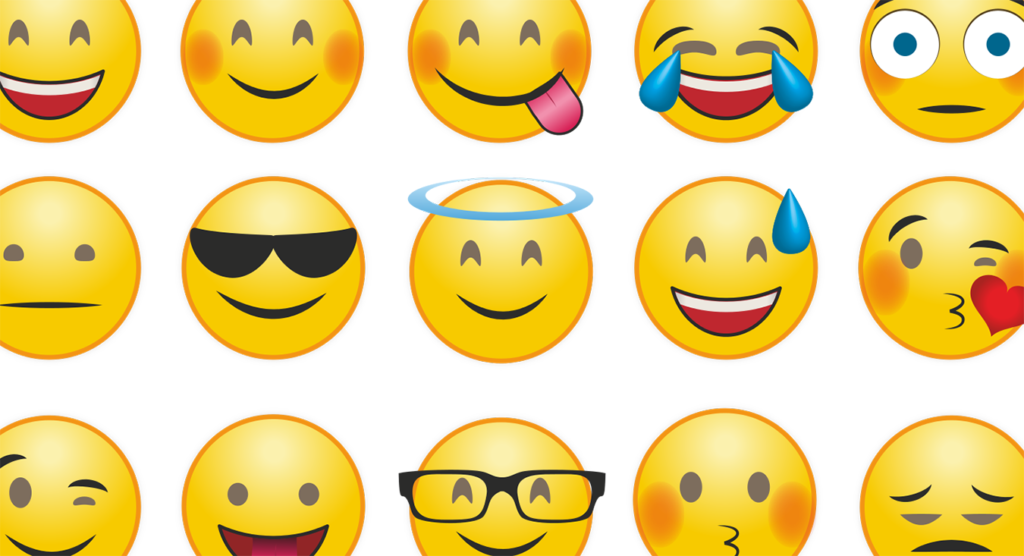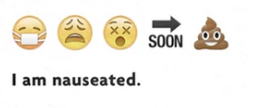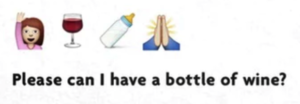Emojis are taking over the world. Are you ready?

Emoji Dick isn’t what it sounds like.
On September 7, 2010, Fred Benenson released a new take on Herman Melville’s classic, Moby Dick – rewritten entirely in 736 pages of emojis.
It followed a successful Kickstarter campaign and involved the work of over 800 people, who spent about 3,795,980 seconds translating approximately 10,000 sentences into the cute little characters we know and love, according to the book’s website.
Then there’s the Emoji Translation Project. It promised a two-part punch: first, to create a physical phrasebook (“Every phrase you’ll need to be understood all around the world in this new and exciting language!”) and a translation engine similar to Google Translate. All to decipher things like:

And

And

(I can’t find any mention of it post-Kickstarter campaign in 2015, though, so I have my doubts as to whether this was actually made.)
If you’re a Deadpool fan or, you know, live in a city with billboards, you probably saw this a few years ago:

Credit: www.dailybillboardblog.com
There’s a #WorldEmojiDay, started by the founder of Emojipedia, Jeremy Burge, where people are encouraged to dress up like their favourite emoji (and maybe even sing the official anthem). It’s “based on the way the calendar emoji is shown on iPhones,” reported the New York Times.
Heck, emojis even have their own (arguably terrible) movie, the first animated movie to be nominated for – and win – the Golden Raspberry awards for Worst Picture, Worst Director, Worst Screen Combo, and Worst Screenplay.
Emojis are everywhere.
The rise of a new visual language
How did we get here? Emojis entered the scene with instant messages and social media posts that had to convey a lot of meaning in short bursts, and launched into the mainstream when Apple included the emoji keyboard in iOS 5.
They’re not just our Facebook likes and reactions. If you’ve been on Instagram lately, you’ll notice nearly half of the text in posts are not text at all – they’re emojis. (Fun fact: Finland uses more emojis than anyone on the platform, making up 63 per cent of its content. Compare that to Tanzania, with only 10 per cent.)
There’s a really good reason for that, according to Hubspot. “Even something as simple as a smiley face emoticon in your post can increase Likes by 57 per cent, comments by 33 per cent, and shares by 33 per cent over posts without them,” they found.
“Emotions engage people even if they’re just a digital doodle.”
It’s so common and so powerful that there’s even a grammar system forming around emoji use, found one doctorate student studying the subject. It breaks down into three central rules:
- They always come at the end of thoughts or messages. Even when they appear in the middle of a tweet, it’s usually spliced after one complete thought and before another, kind of like a punctuation mark.
- There’s an order of operations. Like a comic strip, you’ll read them left-to-right in a sequence (in cultures where left-to-right reading is a thing), not as a whole like a scene like in a painting. Unless there’s a directional suggestion in the emoji itself, like a pointing finger or gun.
- Stance comes first. “Stance” is the attitude or emotion you have about something, usually depicted by the emoji faces. They provide context for the emojis that follow.
And Mailchimp, analyzing emojis in email subject lines, unearthed a grammar of sorts that describes how emoji are used together, in pairs or groups.
- Emojis from the same category (faces, animals, food, weather) are often used together.
- Within broader categories, items that are more similar are more likely to be used together. Think a wine glass and a beer glass, or different types of fruit.
- Some emoji connect different categories together, like the heart and the airplane.
- The sunglasses guy does his own thing. He’s “too cool, in fact, to hang out with the rest of the faces. He is in the middle, and is combined with a wide range of other emojis.”
If you’re a word nerd or grammar geek like I am, watching a system of grammar emerge from the wild west of emoji use is absolutely fascinating.
Now they’re serious business
For years, we’ve been told not to use smiley faces in our professional communications. It’s been taboo to paste them across our official documentation. The formal, impersonal approach was touted for its effect on credibility and professionalism.
And then Chevy went ahead and posted a press release for its 2016 Cruze – using nothing but emojis – under the hashtag #CHEVYGOESEMOJI.
While this not-so-subtle attempt to “appeal to more millennials” is referenced as an example of what not to do and how trying too hard can turn people off, it does make it painfully clear that emoji have crossed the line into more traditional channels.
So what happened to “professionalism” and “credibility?” Is the transition a good thing? Emojis (and their predecessors, emoticons) are a big enough deal that people are studying them, and those studies have shown that:
- Emoticons don’t reduce credibility and instead leave the reader with a better impression of the sender’s personality.
- Our brains light up the same way between a 🙂 or a 🙂 and a real human face.
- People are more likely to feel good about a critical message – and act on it – if it’s accompanied by a smiley face.
- They may actually help us remember what we’ve read.
But they’re not great for first impressions, according to another recent study. They may actually work against you, sending a message that you aren’t competent, warm or friendly. So maybe leave the smileys out of your introductions.
And emojis are not something you’d expect to see in that legal filing from an expensive lawyer, an academic paper from a leading research expert, or a budget breakdown from an accountant. There’s a time and a place.
The question of practicality
How can you harness all of this and use emojis in an effective way – outside of social media? I hate to leave you hanging, but there’s far too much to sum up in one article without making this post massive. So join me for my next one to dig deeper.
